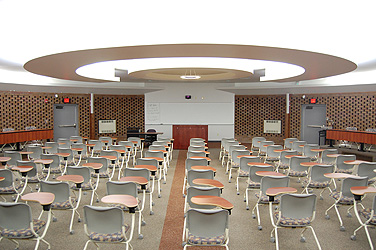News
Classroom renovation project continues

Renovation of 101 Baldy—The Kiva—involved moving walls and a projection booth. The projector is now suspended from the ceiling. Photo: CAPITAL PLANNING GROUP
-
 Print
Print -
 Comments
Comments
-

101 Baldy before the renovation: Members of the Classroom Committee say the room was a “disaster,” with accessibility problems, poor lighting and sound, and virtually no technology. Photo: CAPITAL PLANNING GROUP
UB’s plan to create learning landscape spaces on the North and South campuses continues to forge ahead with the completion of numerous classroom upgrades during the past three summers.
About 11 classrooms have been renovated each year—translating to about 400 seats a year—at an average annual cost of $2.2 million. The renovations include technology upgrades and life-cycle equipment replacement, as well as aesthetic and infrastructure work.
Funding comes from a variety of sources, among them the student technology fee, critical maintenance funds and the Provost’s Office.
“This is a great investment in our students and faculty. It makes their jobs easier,” says Cheryl Bailey, associate director for the Capital Planning Group and a key member of the Instructional Facilities Subcommittee—informally known as the Classroom Committee—that oversees the ongoing project to upgrade the university’s 135 centrally scheduled classrooms on the North and South campuses.
Bailey points out that while classroom renovation work and technology upgrades have been going on for years, the effort became more strategic in 2009 as a result of the university’s comprehensive master planning process. As part of the plan, consultant DEGW provided direction on classroom renovation and “we took a lot of their advice and started moving forward,” she says, noting that work the past three years has focused on creating “enhanced classrooms, flexible classrooms.”
“We’ve changed our direction; not every room has to have tablet armchairs and tile floors,” she adds.
Specifically, renovation work has included the installation of new floors, ceilings, seating, chalk/white boards and improved acoustics in the classrooms, as well as document cameras, new sound systems and new teaching stations that house computers—sometimes both a PC and a Mac—DVD players, VCRs and all technology controls for the classroom.
Among the infrastructure improvements are new tablet chairs with larger tabletops to accommodate larger students and their laptops, lecture halls with power ports in the tabletops so students can plug in their laptops, tiered seating and new acoustic fabric on walls. All classrooms are renovated to meet ADA (Americans with Disability Act) standards.
“We’re really trying to take the learning experience and test it to see how students learn the best,” says Ron Van Splunder, manager, architectural support, Facilities Planning and Design. “I think we’ve got it down now. We have a focus with our enhanced version, where we play with the acoustics, we play with better visual lines and better equipment. We’re hearing more success from people.”
Bailey says that one suggestion that DEGW offered that was new to UB was the creation of “learning corridors.”
“We took unusable places—places where students were gathering, but were just sitting on the floor—and made them very usable,” she says, citing as examples of the concept the ground floor of Knox and the Natural Sciences Complex.
The new “Linear Café” in NSC features work bars with seating along the corridor walls and power ports so students can use their laptops.
“That’s always full—every single chair,” Bailey says of the café. “In fact, in 2010, we added more seats because that was so popular.”
And while nearly all of the centrally scheduled classrooms—about 90 percent—have received some sort of technology upgrade over the years, more work remains.
“In terms of the final fit and finish—that which we now believe is…the direction we want to go in—we’ve got a lot more work to do there, definitely,” says John Pfeffer, service area leader for instructional technology support services, CIT Network and Classroom Services. “We’ve got to go back and touch all the spaces,” he says, noting that UB began adding technology to classrooms in 1995 and “it’s way outdated.”
And back in 1995, the work focused on technology. “Back then we weren’t paying attention to things like the fit and finish of the room—we were primarily focused on the technology,” Pfeffer says. “Now, we’re taking a holistic approach and the end result is higher-quality learning environments and experiences for our students, which is what Instructional Facilities is all about.”
Posing future challenges for the classroom committee is the new digital infrastructure that must be incorporated into all classrooms, Pfeffer notes—for example, upgrading traditional 4x3 television screens to HD 16x10 projection-ratio and adapting the space so instructors can incorporate iPads and other mobile devices into their lectures.
Moreover, there is an increasing demand that what goes on in the classroom be captured for reuse later by students and instructors. That means the installation of video cameras and microphones, he says.
And how do you collaborate, in real-time, with someone in Singapore?
“The old, traditional, distance-learning classrooms are rapidly going the way of the dinosaur,” Pfeffer says. “Every room is going to need to have the technical capability to enable collaboration in real-time with distance learners and distant subject-matter experts.
“That’s the challenge we’re faced with—getting that new digital infrastructure in place.”
“So we’re never really done,” Bailey adds.

Reader Comments